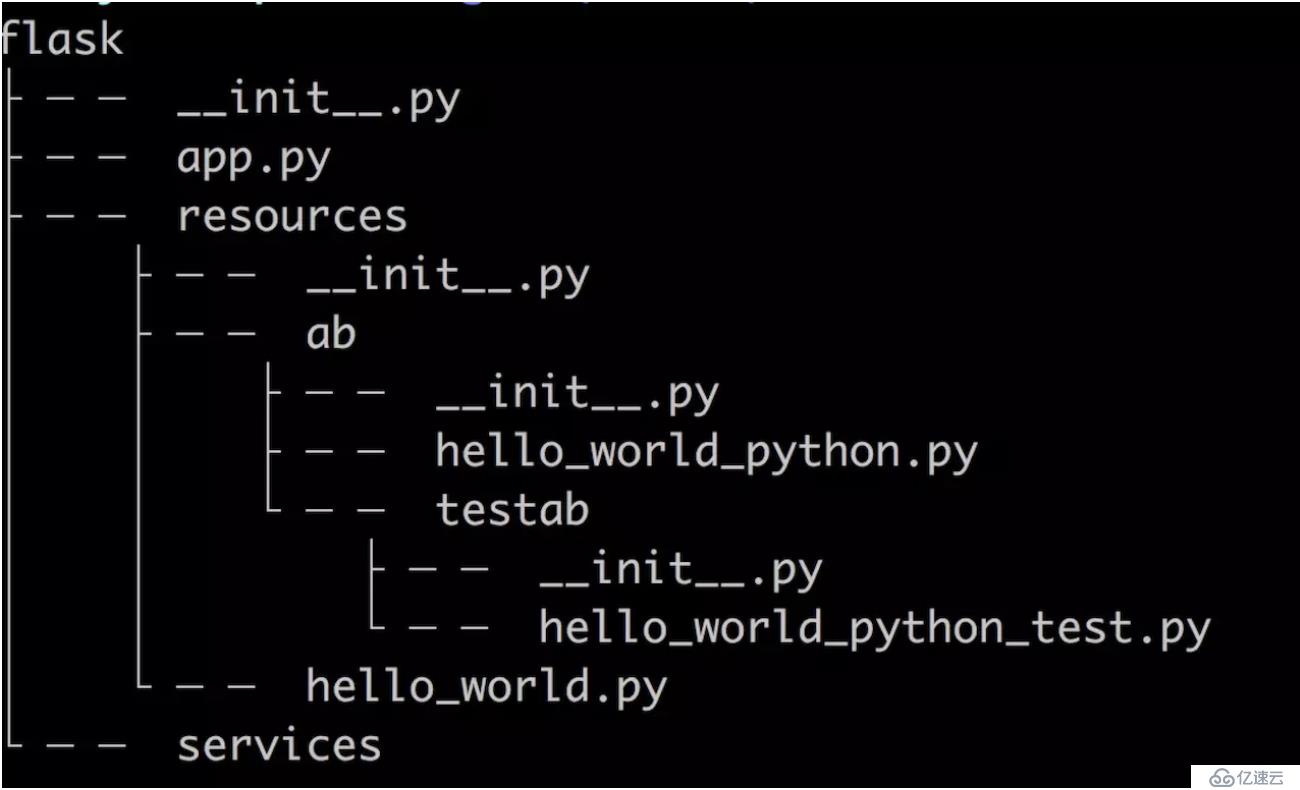您好,登錄后才能下訂單哦!
您好,登錄后才能下訂單哦!
隨著業務的飛速發展,API接口越來越多,路由管理文件從幾十號變成幾百上千行,且每次上新服務,需要在修改路由文件代碼,帶來一定的風險。

制定對應規則,路由通過API文件名根據一定的規則對應類名,然后自動導入對應實現類,注冊到Web框架中。
下面這套規則只是其中一種方案,可以針對項目情況制定對應的規則,然后實現相關代碼,但是整體思路基本一樣。
代碼目錄結構,列一下簡單的項目文件目錄,下面以flask框架為例:
app.py是啟動文件。
resources是API接口代碼文件夾。
services是為API接口服務的函數封裝文件夾。
如果項目還有依賴文件,也可以單獨再建其他文件夾。
項目的API接口代碼均放在resources文件夾下,且此文件夾只能寫接口API服務代碼。
接口名稱命名以_連接單詞,而對應文件里的類名文件名稱的單詞,不過換成是駝峰寫法。
規則舉例如下:
如上圖,resources下有一個hello_world接口,還有一個ab項目文件夾,ab下面還有一個hello_world_python接口以及子項目文件夾testab, testab下面也有一個hello_world_python.
接口文件的文件名命名規范:
文件名命名均為小寫,多個單詞之間使用'_'隔開,比如hello_world.py 命名正確,helloWorld.py命名錯誤。


路由入口文件會自動映射,映射規則為:
前綴 / 項目文件夾[...] / 文件名
其中 前綴為整個項目的路由前綴,可以定義,也可以不定義,比如api-ab項目,可以定義整個項目的路由前綴為 ab/
resource下面項目文件夾如果有,則會自動拼接,如果沒有,則不會讀取。
舉例:
前綴為空,上圖resources中的三個接口對應的路由為:
hello_world.py ==> /hello_world
ab/hello_world_python.py ==> /ab/hello_world_python
ab/testab/hello_world_python.py ==> /ab/testab/hello _world_python前綴為ab/,上圖resources中的三個接口對應的路由為:
hello_world.py ==> ab/hello_world
ab/hello_world_python.py ==> ab/ab/hello_world_python
ab/testab/hello_world_python.py ==> ab/ab/testab/hello_world_pythonpython很多框架的啟動和路由管理都很類似,所以這套規則適合很多框架,測試過程中有包括flask, tornado, sanic, japronto。 以前年代久遠的web.py也是支持的。
完整代碼地址:
https://github.com/CrystalSkyZ/PyAutoApiRoute
實現下劃線命名 轉 駝峰命名 函數,代碼演示:
def underline_to_hump(underline_str):
'''
下劃線形式字符串轉成駝峰形式,首字母大寫
'''
sub = re.sub(r'(_\w)', lambda x: x.group(1)[1].upper(), underline_str)
if len(sub) > 1:
return sub[0].upper() + sub[1:]
return sub實現根據字符串導入模塊函數, 代碼演示:
通過python內置函數__import__函數實現加載類
def import_object(name):
"""Imports an object by name.
import_object('x') is equivalent to 'import x'.
import_object('x.y.z') is equivalent to 'from x.y import z'.
"""
if not isinstance(name, str):
name = name.encode('utf-8')
if name.count('.') == 0:
return __import__(name, None, None)
parts = name.split('.')
obj = __import__('.'.join(parts[:-1]), None, None, [parts[-1]], 0)
try:
return getattr(obj, parts[-1])
except AttributeError:
raise ImportError("No module named %s" % parts[-1])importlib.import_module(name)上面2種方法都可以,github上代碼里2種方法都有測試。
檢索resources文件夾,生成路由映射,并導入對應實現類, 代碼演示如下:
def route(route_file_path,
resources_name="resources",
route_prefix="",
existing_route=None):
route_list = []
def get_route_tuple(file_name, route_pre, resource_module_name):
"""
:param file_name: API file name
:param route_pre: route prefix
:param resource_module_name: resource module
"""
nonlocal route_list
nonlocal existing_route
route_endpoint = file_name.split(".py")[0]
#module = importlib.import_module('{}.{}'.format(
# resource_module_name, route_endpoint))
module = import_object('{}.{}'.format(
resource_module_name, route_endpoint))
route_class = underline_to_hump(route_endpoint)
real_route_endpoint = r'/{}{}'.format(route_pre, route_endpoint)
if existing_route and isinstance(existing_route, dict):
if real_route_endpoint in existing_route:
real_route_endpoint = existing_route[real_route_endpoint]
route_list.append((real_route_endpoint, getattr(module, route_class)))
def check_file_right(file_name):
if file_name.startswith("_"):
return False
if not file_name.endswith(".py"):
return False
if file_name.startswith("."):
return False
return True
def recursive_find_route(route_path, sub_resource, route_pre=""):
nonlocal route_prefix
nonlocal resources_name
file_list = os.listdir(route_path)
if config.DEBUG:
print("FileList:", file_list)
for file_item in file_list:
if file_item.startswith("_"):
continue
if file_item.startswith("."):
continue
if os.path.isdir(route_path + "/{}".format(file_item)):
recursive_find_route(route_path + "/{}".format(file_item), sub_resource + ".{}".format(file_item), "{}{}/".format(route_pre, file_item))
continue
if not check_file_right(file_item):
continue
get_route_tuple(file_item, route_prefix + route_pre, sub_resource)
recursive_find_route(route_file_path, resources_name)
if config.DEBUG:
print("RouteList:", route_list)
return route_list以flask框架為例,其余框架請看github中的代碼演示。
app.py 中代碼
app = Flask(__name__)
api = Api(app)
# APi route and processing functions
exist_route = {"/flask/hello_world": "/hello_world"}
route_path = "./resources"
route_list = route(
route_path,
resources_name="resources",
route_prefix="flask/",
existing_route=exist_route)
for item in route_list:
api.add_resource(item[1], item[0])
if __name__ == "__main__":
app.run(host="0.0.0.0", port=int(parse_args.port), debug=config.DEBUG)運行app.py之后,路由打印如下:
RouteList: [
('/hello_world', <class'resources.hello_world.HelloWorld'>),
('/flask/ab/testab/hello_world_python_test', \
<class 'resources.ab.testab.hello_world_python_test.HelloWorldPythonTest'>),
('/flask/ab/hello_world_python', <class 'resources.ab.hello_world_python.HelloWorldPython'>)
]元組第一個元素則是路由,第二個元素是對應的實現類。
總結:
至此,通過制定一定規則,解放路由管理文件方案完成。 歡迎各位一起討論其余比較好的方案,更多方案討論可以關注微信公眾號: 天澄的技術筆記 。 
免責聲明:本站發布的內容(圖片、視頻和文字)以原創、轉載和分享為主,文章觀點不代表本網站立場,如果涉及侵權請聯系站長郵箱:is@yisu.com進行舉報,并提供相關證據,一經查實,將立刻刪除涉嫌侵權內容。